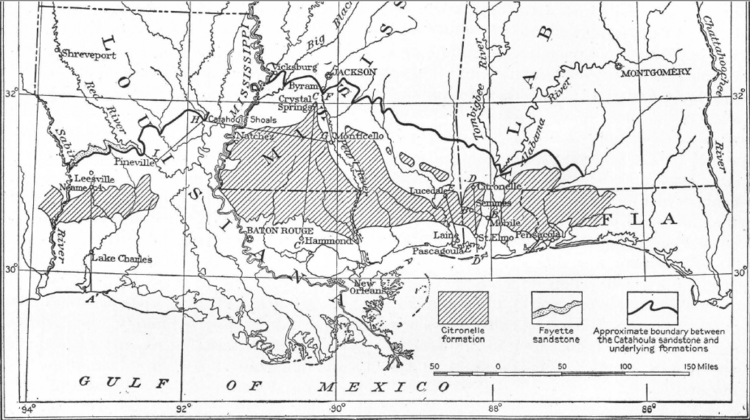Citronelle Formation facts for kids
Quick facts for kids Citronelle FormationStratigraphic range: Early Pliocene (late Hemphillian) ~5.3–4.9Ma |
|
|---|---|

Outcrops of the Citronelle Formation in Georgia, in front of and below the train engine
|
|
| Type | Formation |
| Lithology | |
| Primary | Claystone, sandstone |
| Other | Marl |
| Location | |
| Coordinates | 30°48′N 88°06′W / 30.8°N 88.1°W |
| Approximate paleocoordinates | 31°00′N 86°24′W / 31.0°N 86.4°W |
| Region | Alabama, Louisiana, Florida, Mississippi |
| Country | |
The Citronelle Formation is a special type of rock layer found in the southeastern United States. It helps scientists learn about Earth's past. This formation is from a time called the Pliocene epoch. This was about 5.3 to 4.9 million years ago.
Contents
What is the Citronelle Formation?
A geologic formation is like a specific chapter in Earth's history book. The Citronelle Formation is a thick layer of rock and sediment. It was formed a very long time ago. Scientists study it to understand ancient environments.
Where is it found?
You can find the Citronelle Formation in several states. These include Georgia, Alabama, Florida, Mississippi, and Louisiana. It covers a wide area across these states.
What is it made of?
The Citronelle Formation is mostly made of claystone and sandstone. Claystone is like hardened clay. Sandstone is rock made from sand grains. Sometimes, it also contains marl, which is a mix of clay and limestone. These materials tell us about how the area looked millions of years ago.
Ancient Life: Fossils in the Citronelle Formation
The Citronelle Formation is important because it holds fossils. Fossils are the preserved remains or traces of ancient life. They give us clues about the plants and animals that lived millions of years ago.
What kinds of fossils are found?
Scientists have found many different types of fossils here. These include ancient mammals, reptiles, and sea creatures. Studying these fossils helps us understand how life has changed over time.
Here are some of the fossils discovered in the Citronelle Formation:
- Nannippus cf. lenticularis (an ancient horse)
- Neohipparion eurystyle (another ancient horse)
- Pomatodelphis inaequalis (an ancient dolphin)
- Synthetoceras cf. tricornatus (an ancient horned mammal)
- Anomia taylorensis (a type of ancient oyster)
- Cassidulus gouldii (a type of ancient sea urchin)
- Chlamys chickaria (a type of ancient scallop)
- Chlamys gainstownensis (another ancient scallop)
- Chlamys glendonensis (another ancient scallop)
- Chlamys mcquirti (another ancient scallop)
- Kuphus incrassatus (a type of ancient shipworm)
- Pecten howei (a type of ancient scallop)
- Caretta sp. (an ancient sea turtle)
- Teleoceras sp. (an ancient rhinoceros)
- Trionyx sp. (an ancient softshell turtle)
- Camelidae indet. (fossils from an ancient camel family)
- Cervidae indet. (fossils from an ancient deer family)
- Scombroidei indet. (fossils from an ancient mackerel or tuna family)


